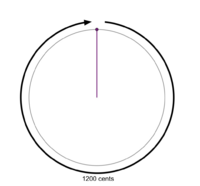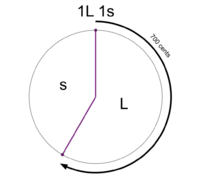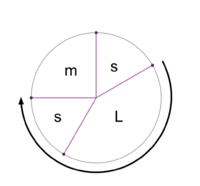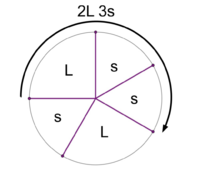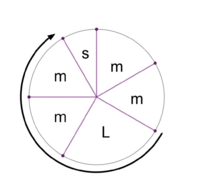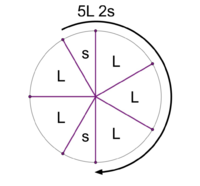User:Nick Vuci/Moments of Symmetry: Difference between revisions
| Line 13: | Line 13: | ||
</gallery> | </gallery> | ||
== Step | == Step Ratios == | ||
<gallery mode="nolines" widths="200" heights="200"> | The [[step ratio]] (also simply called the ''hardness'') of MOS denote the relative sizes of the large and small steps and is an important factor for classifying MOS patterns. For a more thorough discussion on the spectrum of step ratios, please see [[TAMNAMS#Step ratio spectrum|TAMNAMS]].<gallery mode="nolines" widths="200" heights="200"> | ||
File:5L 2s hard.png|When the L:s ratio is 3:1, the MOS is hard. 17-EDO contains the hard 5L 2s. | File:5L 2s hard.png|When the L:s ratio is 3:1, the MOS is hard. 17-EDO contains the hard 5L 2s. | ||
File:Basic 5L 2s.png|When the L:s ratio is 2:1, the MOS is basic. 12-EDO contains the basic 5L 2s. | File:Basic 5L 2s.png|When the L:s ratio is 2:1, the MOS is basic. 12-EDO contains the basic 5L 2s. | ||
File:5L 2s soft.png|When the L:s ratio is 3:2, the MOS is soft. 19-EDO contains the soft 5L 2s. | File:5L 2s soft.png|When the L:s ratio is 3:2, the MOS is soft. 19-EDO contains the soft 5L 2s. | ||
</gallery> | </gallery> | ||
== Spectrum of MOS == | |||
Revision as of 04:23, 28 May 2025
WORK-IN-PROGRESS AS OF 27 MAY 2025
Moments of Symmetry (MOS) are scales created by a simple procedure that generates the common pentatonic and diatonic scales, but also extends their melodic coherence and structural balance to a wide range of novel xenharmonic scales. First described by Erv Wilson in the 1970's, the concept shares fundamental similarities and is often thought of as synonymous with the concept of Well-Formed scales, as well as the more generalized concept of MV2 scales. Over time, MOS has become a central tool in xenharmonic theory, inspiring a wide range of musical uses, analytical approaches, and derivative concepts such as MODMOS, multi-MOS, and MOS-based rhythm.
Construction
-
An interval is chosen to be the period (the 1200 cent octave in this example). The period is represented with a circle; intervals are represented with purple lines and points radiating out from the middle which move clockwise.
-
An interval is chosen to be a generator (the 700 cent perfect fifth in this example). This is the 1L 2s MOS pattern.
-
Stacking the generator upon itself yields a scale with 2 step sizes. This is the 2L 1s MOS pattern.
-
Stacking the generator 2 times yields a scale with 3 step sizes (not MOS).
-
Stacking the generator 3 times yields a scale with 2 step sizes. This is the 2L 3s MOS pattern.
-
Stacking the generator five times yields a scale with three step sizes (not MOS).
-
Stacking the generator 6 times yields a scale with 2 step sizes. This is the 5L 2s MOS pattern.
Step Ratios
The step ratio (also simply called the hardness) of MOS denote the relative sizes of the large and small steps and is an important factor for classifying MOS patterns. For a more thorough discussion on the spectrum of step ratios, please see TAMNAMS.
-
When the L:s ratio is 3:1, the MOS is hard. 17-EDO contains the hard 5L 2s.
-
When the L:s ratio is 2:1, the MOS is basic. 12-EDO contains the basic 5L 2s.
-
When the L:s ratio is 3:2, the MOS is soft. 19-EDO contains the soft 5L 2s.
